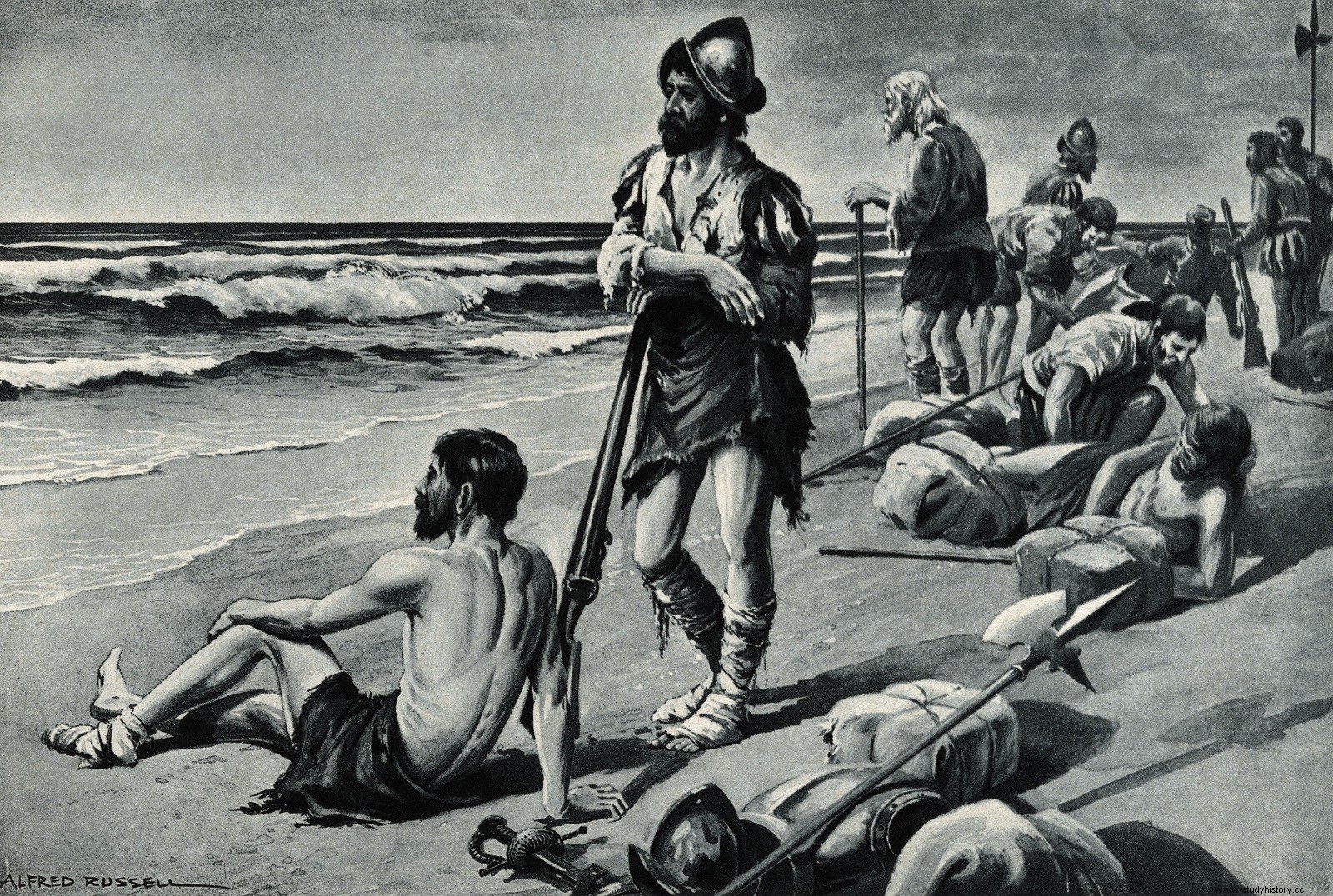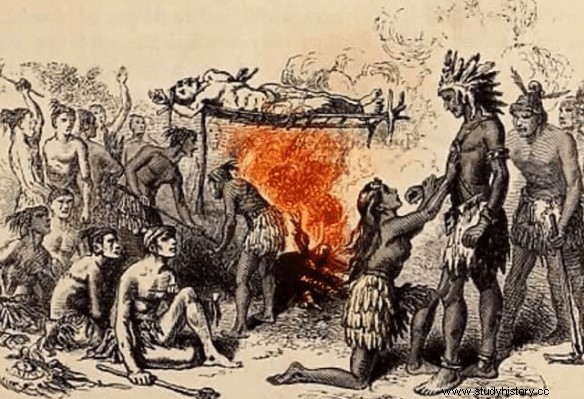On June 17, 1527, he left Sanlúcar de Barrameda (Cádiz), heading for the colonization of Florida, an expedition led by Pánfilo de Narváez . After various setbacks (desertions, storms and hurricanes, wrong decisions...) they arrived in Tampa Bay (Gulf of Mexico) in April 1528. After the first contacts with the natives of the area, in this case we can speak of friendly relations , Narváez decided to divide the force into a land and a maritime contingent:three hundred men by land to the north and the three ships, with the rest of the expedition, would sail along the coast following closely in case they were needed. The land contingent, with Narváez in the lead, advanced inland, making everything they found their own and leaving too many enemies in their wake (here there was little good vibes left)… until they entered Appalachian territory. Their adventures preceded them and they were not willing to suffer them in their flesh. The ambushes, the theft of supplies and the continuous harassment forced Narváez to abandon the idea of going further north and he decided to return to the coast to seek the refuge of his ships. But they were gone.

What happened to the maritime contingent? Following Narváez's instructions, they had sailed north unaware that the land expedition had decided to return to the starting point. Without hearing from them and with supplies already running low, they decided to return to Havana. They re-supplied and returned to look for Narváez and his men. Ships roamed the coast for a year, but no trace. They anchored in Tampa Bay and from one of the ships a boat was sent ashore with four sailors to search for any indication of their whereabouts. As soon as they landed, the Spaniards were captured by the indigenous people who were watching the flotilla. Narváez's land expedition had left many pending debts between the indigenous people and any Spaniard who approached their territory was going to pay them. They were brought before the cacique Hirrihigua , who decided to deliver three of them to his warriors and reserve our protagonist, the sailor Juan Ortiz, for a ritual similar to the martyrdom of San Lorenzo:put it on a kind of grill and burn it alive. When he was about to be set on fire, Ulele , the chief's daughter, hugged the Spaniard and begged her father to spare her life.
What harm can one man do us? – the princess begged

Hirrihigua, reluctantly, took pity on that poor little Spaniard and agreed to his daughter's request. Juan Ortiz became a slave of the tribe, forced to perform the most painful and dangerous tasks. Despite the fact that with his determination and industriousness he earned the respect of a large part of the community, the cacique was still suspicious of that white-faced man. In fact, Ulele would save her life again when she found out that her father had recovered the idea of eliminating him, and she prepared an escape plan for that same night. They would never see each other again. This is the extent of the known history of Ulele, and that of Juan Ortiz continues in the tribe of another cacique until he managed to escape and in 1539, almost twelve years after his capture, he met the expedition of Hernando de Soto . A man came out of the forest...
Gentlemen, for the love of God and Holy Mary, do not kill me, I am a Christian like you, and I am from Seville and my name is Juan Ortiz.
From that moment, and until his death in 1542, near the Mississippi River, Juan Ortiz became the interpreter who accompanied Hernando de Soto in Florida. At this point, doesn't it remind you of the story of the English explorer John Smith and Pocahontas? To me a lot. Too much, I would say.

In 1995 the animated film Pocahontas was released. , a Disney factory production that told the story of an English explorer named John Smith and a Native American Indian princess named Matoaka —the Pocahontas thing it was an affectionate name that can be translated as “Naughty ”—, a conveniently sweetened film by Walt Disney Pictures and based on the autobiographical works of John Smith. The first reference to Pocahontas appears in “A True Relation of Virginia ”(1608), but at no time does the explorer speak of the passage in which the princess saves his life by throwing herself on top of the explorer and protecting him when he was going to be executed by order of his father. This fact is cited for the first time in a letter that John Smith sent to England in 1616, anticipating the trip of Pocahontas and her husband John Rolfe, and later in his work “ The General Historie of Virginia ” (1624). So, did anything happen after 1608 that she made John Smith 'remind' of the romantic part of his captivity? You are right. Specifically, the publication in 1609 of “Virginia Richly Valued, by the Description of the Maine Land of Florida:Her Next Neighbor ”. In this book, whose author was the English writer and historian Richard Hakluyt, the discoveries of Hernando de Soto in Florida or the history of the Spanish explorer Juan Ortiz and the Indian woman Ulele are narrated, among many other vicissitudes.
So, if to the good salesmen who have been English throughout history we add our legendary inexperience in these matters, just as John Smith endorsed that story that occurred eighty years before his encounter with Pocahontas.

Ulele statue at Ulele Restaurant (Tampa, Florida)
